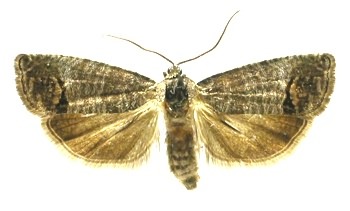Pests
Cydia pomonella L. - Codling Moth.
Systematic position.
Class Insecta, order Lepidoptera, family Tortricidae, subfamily Olethreutinae, tribe Laspeyresiini, genus Cydia.Synonyms.
Grapholitha pomonella L., Laspeyresia pomonella L., Laspeyresia putaminana Stgr., Carpocapsa pomonella L.Biological group.
It is an oligophagous pest of fruit crops.Morphology and biology.
Wingspan is 14-21 mm. Forewings dark gray, with transversal sinuate lines, at apex with reddish-brown spot having bronze tint. Hind-wings lighter, with marginal fringe. Sitting moth folds wings like roof. Egg grayish, flattened, to 1 mm in diameter. Caterpillar is 12-18 mm long, light pink or yellowish-white and with brown head. Pupa is yellowish-brown, 9-12 mm long. Male pupa with four movable articulated abdominal segments and with cremaster merged of three last segments, whereas female pupa having three and four segments, correspondingly. Fertility of moths is 60-120 eggs on the average. Female lays eggs one by one on fruits and leaves, on their upper side mainly, avoiding pubescent leaves. Eggs develop in 5-14 days. Penetrating into pulp of fruit, hatched caterpillar closes the entrance aperture with a plug of bits, making a chamber, where the first molt occurs. Next molt occurs in seed chamber. Caterpillars of 3rd instar eat seeds, but can also develop eating pulp only. Caterpillars of 4th instar make a return hole to fruit surface, being able to populate the 2nd fruit. After 4th molt the caterpillars stop feeding, leave fruit and cocoon. The caterpillar development lasts 22 days in the south to about 45 days in the north. Pupae develop over 2-3 weeks. Older caterpillars winter in compact cocoons.Distribution.
Primary area occupies Middle Europe, the Mediterranean, Minor and Central Asia. Now the species is found in Europe (except for Far North), Northern and Southern Africa, Pakistan, China, America, South Australia, New Zealand; in Baltic States, Byelorussia, Ukraine, Moldova, Transcaucasia, Kazakhstan and Central Asia. In Russia it is distributed throughout all of the European part except for the north), in Ural, southern Siberia and the Far East (Amur Region, Khabarovsk and Primorskii Territories).Ecology.
In forest zones this species produces up to 1-1.5 generations, in steppe zones 2-3, in Transcaucasia and Central Asia to 4 generations. Pupation of wintered caterpillars begins at an average daily temperature of 10° C, lasting one month in the north area, 1.5-2 months in Ukraine. Mass pupation coincides with flowering of early varieties of apple. Flight of imago occurs in spring at temperatures not lower than 16-17° C, being observed soon after flowering of apple, reaching a maximum in 2-3 weeks during the formation of seed-buds. Moths require drop moisture after appearance. Moths of 2nd generation appear during the flight of the moths of the 1st generation. Therefore, all stages of the pest development may be observed in nature. Moths are active after sunset during windless weather. Degree days (DD) for development of one generation are 500-600 degrees in the north area, exceeding 750° in southern zones. Development of 2nd generation is possible if DD accumulate until August 2, then all caterpillars diapause. DD for development of 2 full generations is 1300-1400°. Diapausing caterpillars usually cocoon under the bark of apple trunks.Economic significance.
Crab and cultivated apples are the main host plants; the pest strongly causes harm to fruits of pear and quince, occasionally causes harm to drupaceous plants, e.g., peach, apricot; and pomegranate. As an exception, it is found on plums and oranges. In southern areas it is an important pest of fruits of walnut. Caterpillars mine fruits, eat seeds. Control measures are as follows. Agronomical: clearing trunks and branches of old bark, removing of vegetation residues, scalding, by boiled water, of props and containers after use, plowing of ground for destruction of wintering caterpillars; burning of rubbish and unusable packing materials in gardens, on platforms and in fruit storages; trapping of caterpillars on trunks in their middle part and on large branches at their base; surveillance of the traps and destruction of caterpillars every 10 days; collecting of fruits that drop with subsequent removal of them from gardens. Biological: release of Trichogramma in gardens, application of biological preparations. Chemical: treatment by insecticides during hatching of caterpillars before their penetration into fruits in the centers populated with the pest. Forecasting and signaling with the help of pheromone traps, meteo-monitoring and phenol-monitoring.Reference citations:
D.yakonov A.M., Kozhanchikov I.V. 1949. Lepidoptera. In: Pavlovskii E.N., Shtakelberg A.A., eds. Pest Animals of Middle Asia (handbook). Moscow-Leningrad: AN SSSR. 179-198 p. (In Russian)Danilevskii A.S., Kuznetsov V.I. 1968. Tortricidae, tribe Laspeyresiini. In: Bykhovskii B.E., ed. Fauna of the USSR, new ser. N. 98. Lepidoptera. V. 5(1). Moscow-Leningrad: AN SSSR. 636 p. (In Russian)
Ermolaev V.P. 1988. Tortricidae. In: Kirpichnikova V.A., Ler P.A., eds. Butterflies-pests of agriculture in the Far East. Keys. Vladivostok: Biology and Soil Institute, DO AN SSSR. 65-99 p. (In Russian)
Kostyuk Yu.A. 1974. Family Tortricidae. In: Vasil.ev V.P., ed. Pests of agricultural crops and forest plantations. V. 2. Arthropods. Kiev: Urozhai. 261-320 p. (In Russian)
Kuznetsov V.I. 1994. Family Tortricidae. In: Kuznetsov V.I., ed. Insects and mites - pests of agricultural plants. V. 3(1). Lepidoptera. St. Petersburg: Nauka. 51-234 p. (In Russian)
Prokof.ev M.A. 1987. Siberian orchards protection against pests. Moscow: Rossel.khozizdat. 239 p. (In Russian)
Vasil.ev V.P., Livshits I.Z. 1984. Pests of fruit crops. Moscow: Kolos. 399 p. (In Russian)


